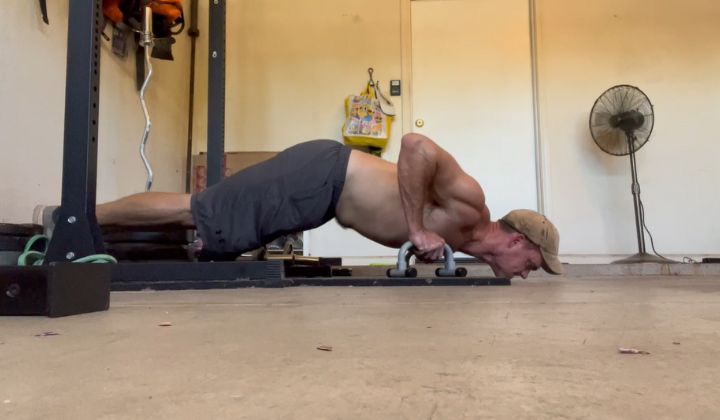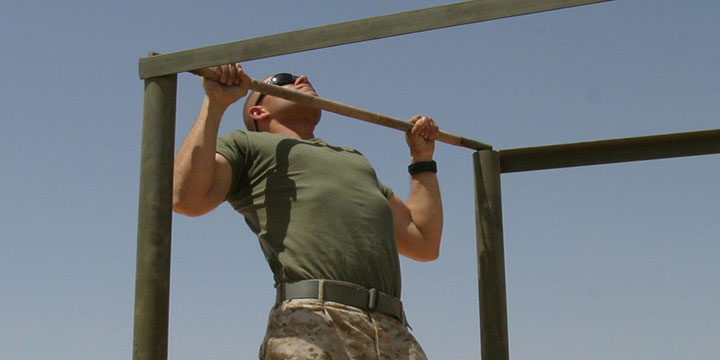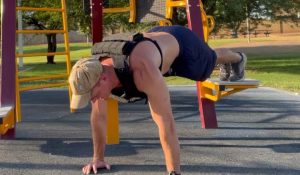Designed by prisoners in one of Mexico’s infamous prisons and popularized by Josh Bryant of Jailhouse Strong, the Juarez Valley prison workout is as brutal as it is simple.
At its core, the Juarez Valley method is simply back-and-forth descending and ascending pyramid workouts done simultaneously. However, it’s notorious for adding slabs of muscle to the inmates who perform it regularly.
Here’s how to do it:
How to do Juarez Valley push-ups, squats, or pull-ups
The Juarez Valley method of calisthenics is extremely simple. You’ll simply pick a “high” number of an exercise (we’ll use 10 as an example below), and complete that number of reps. Then, you’ll walk across the room and complete one rep of that exercise. Then, you’ll walk back to the starting position, complete nine reps, walk back, complete two reps, and so on.
Eventually, the two pyramids will meet in the middle, forming the valley:
- 10 reps
- 1 rep
- 9 reps
- 2 reps
- 8 reps
- 3 reps
- 7 reps
- 4 reps
- 6 reps
- 5 reps
- 5 reps
- 6 reps
- 4 reps
- 7 reps
- 3 reps
- 8 reps
- 2 reps
- 9 reps
- 1 rep
- 10 reps
The key is to only walk from one end of the room to another. Remember, this method was designed to be used in the confines of a prison cell!
The extremely short rest periods mean that the volume will sneak up on you over the course of the workout. You’ve been warned!
What exercises to choose for the Juarez Valley method
It doesn’t take much imagination to extend this method into other exercises, but remember that this method was designed and used by prisoners who had access to no equipment – that’s the point. To maintain the integrity of the system, I limit this method to the basics:
- Juarez Valley push-ups
- Juarez Valley squats (or lunges)
- Juarez Valley pull-ups or towel rows
If you had a place to do them, you could certainly incorporate dips into this routine as well, but I wouldn’t go too far beyond that.

Juarez Valley push-ups
Juarez Valley push-ups are as brutal as they are simple. Taking extremely short breaks with repeated sub-maximal sets will take its toll through the course of the workout, and that’s the point. The beauty of using the Juarez valley method is that you’ll create a crazy chest and triceps pump in just a few minutes.
When doing Juarez Valley push-ups, start by choosing a number that’s manageable. I recommend taking full push-ups max, and dividing it by four to get your initial set. So, if your honest to God, full range of motion max is 50, then start with 12 for your starting set.
From there, you can regulate the difficulty up or down based on how easy it was for you to complete the 12 reps.

Juarez Valley squats
If you’re looking to build tree trunks with no equipment, then Juarez Valley squats may be the quickest way to get there. Since most of us (hopefully) are able to do more air squats than push-ups, the number of reps we can do gets jacked into the stratosphere.
Since it’s near impossible to determine a “max” for air squats, I would recommend simply testing how many full range of motion air squats you can complete in two minutes, and then dividing the number by four to get your initial set of Juarez Valley squats.
Don’t spend any time “resting” at the top of the rep. Remember that the top of a squat is standing. We want you working for each set. You could even cut the range of motion slightly at the top to create a constant tension squat. However, don’t cut the range of motion at the bottom – break parallel with each rep.
During the course of the workout, the quad burn you’ll start to feel will be insane.

Juarez Valley pull-ups
If you’re looking to create a full physique and total body strength using the Juarez Valley method, then you must include a back exercise. Few exercises create a fearsome physique as quickly as a few months of dedicated effort towards the pull-up.
Since pull-ups can be a heavy duty exercise, I’d recommend starting with no more than half of your max, and adding reps over time as the workout becomes too easy.
Alternatively, if you don’t have access to a pull-up bar, the towel row is an excellent no-equipment alternative. Wrap a long towel or rope around an upright pillar or door frame, and pull the arms in to the side as if you performing any other kind of row.
If you choose the towel row (or any other kind of inverted row) as your main exercise, I would do it the same way you did your push-ups: take the max number of full range of motion repetitions you can complete, and divide it by four to get your starting number.
Combine exercises using the Juarez Valley Method
Here’s where things get interesting. For a more complete workout, you can easily combine exercises into a single Juarez Valley session. Here are a few variations to try:
- Push-ups descending, pull-ups ascending for a brutal antagonistic superset (use a 2:1 ratio of push-ups to pull-ups)
- Squats descending, push-ups ascending for a quick upper / lower superset
- Dips descending, push-ups ascending for a brutal agonistic superset (you could just as easily apply this to pull-ups and rows)
- Squats descending, reverse lunges ascending for quads / hams leg superset
If you’re insane, use a weight vest
When it comes to jacking up the difficulty of basic calisthenics, few methods are as simple or as elegant as adding a weighted vest to your basic strength movements. If you find that the number of reps you’re completing becomes ludicrous, adding a weighted vest or backpack is a great way to jack up the muscle-building stimulus.
If you’ve never used a weighted vest before, start with 10% of your bodyweight. That being said, I’ve used vests as heavy as 75 pounds for Juarez Valley workouts. Make sure you have a base of strength before you go too crazy with the vest weight.
If you don’t have a weighted vest, a few 10 or 25lb plates in a backpack works just as well.
Fitting Juarez Valley workouts into your routine
The beauty of the Juarez Valley method is that it is a natural micro-workout. That being said, there are a few ways to use this method to your benefit:
As a standalone workout
If you’re planning on using Juarez Valley training as a standalone workout, then start with the number of reps recommended above, and progress from there. As the reps grow into the 20’s, the length of the session will grow, and you’ll note that a single Juarez Valley session can be as hypertrophic as a full bench press session in the gym.
If you choose this method, you’ll likely want to split the workouts into some sort of push, pull, legs, upper / lower, or calisthenic body part split separating the exercises onto their respective days of the week.
As a finisher
If you’re not in prison or strapped for time, probably the most typical way to use the Juarez Valley method is as a workout finisher. Try the following:
- Juarez Valley push-ups after a hard bench press or chest / tris session
- Juarez Valley rows or pull-ups after a hard back session
- Juarez Valley pull-up and push-up supersets after a chest / back session
- Juarez Valley lunges or squats after a hard leg session
For extra conditioning
If you’ve got a few minutes to spare at the end of your workout for a hard conditioning finisher, try completing a pyramid-style burpee workout using the Juarez Valley method. If you start with 10, you’ll have completed 110 burpees in a short amount of time.
Be prepared to lay on the floor for a bit before you leave the gym!
As a micro workout
If you’re planning on squeezing in Juarez Valley training session as a micro workout between other activities you’re doing throughout the day, then increase the frequency to 5-7 days per week, but keep the reps to what you can complete in under 10-12 minutes.
Here’s an interesting AM/PM way to do it that could truly fit into anyone’s schedule:
- Mon: Push-ups in the morning, pull-ups in the evening
- Tues: Squats in the morning, push-ups in the evening
- Wed: Pull-ups in the morning, squats in the evening
- Thurs: Push-ups in the morning, pull-ups in the evening
- Fri: Squats in the morning, push-ups in the evening
- Sat: Pull-ups in the morning, squats in the evening
- Sun: Off
This method would have you completing push-ups, squats, and pull-ups each four times per week, for a very minimal time investment.





















